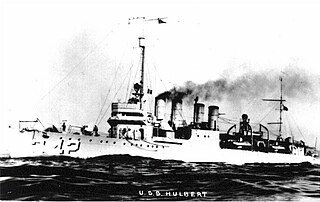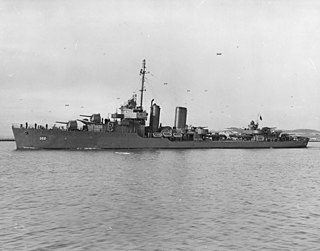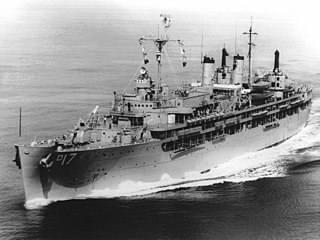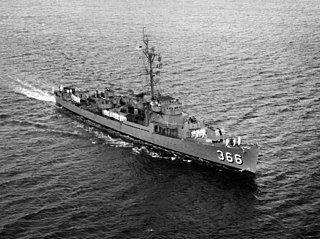
USS Acadia (AD-42) was a Yellowstone-class destroyer tender in the service of the United States Navy, named after Acadia National Park. She was inactive and in reserve after her 1994 decommissioning at Naval Inactive Ship Maintenance Facility (NISMF), Pearl Harbor, Hawaii, under maintenance category B, until sunk off Guam during a live-fire training exercise on 20 September 2010. She was the first ship to house a wartime mixed-sex crew and was unofficially nicknamed "The Love Boat" in the 1991 Persian Gulf War after 36 women became pregnant during deployment.

USS Stembel (DD-644) was a Fletcher-class destroyer in service with the United States Navy from 1942 to 1947 and from 1951 to 1958. In 1961, she was transferred to Argentina where she served as ARA Rosales (D-22). She was scrapped in 1982.

USS Goldsborough (DD-188/AVP-18/AVD-5/APD-32) was a Clemson-class destroyer in the United States Navy during World War II. She was the second Navy ship named for Rear Admiral Louis M. Goldsborough (1805–1877). Entering service in 1920, the ship had a brief active life before being placed in reserve in 1922. Goldsborough was reactivated for World War II and was used as an aircraft tender, destroyer and high speed transport in both Atlantic and Pacific theaters. Following the war, the ship was sold for scrapping in 1946.

USS Wright (AZ-1/AV-1) was a one-of-a-kind auxiliary ship in the United States Navy, named for aviation pioneer Orville Wright. Originally built as a kite balloon tender, she was converted into a seaplane tender after kite balloons were no longer used.

USS Albemarle (AV-5) was one of only two Curtiss-class seaplane tenders built for the United States Navy just prior to the United States' entry into World War II. Named for Albemarle Sound on the North Carolina coast, she was the third U.S. Naval vessel to bear the name. Albemarle was laid down on 12 June 1939 at Camden, New Jersey, by the New York Shipbuilding Corporation, and launched on 13 July 1940, sponsored by Mrs. Beatrice C. Compton, the wife of the Honorable Lewis Compton, Assistant Secretary of the Navy. She was commissioned at the Philadelphia Navy Yard on 20 December 1940, with Commander Henry M. Mullinnix in command. She was transferred to the Maritime Administration (MARAD) James River Fleet at Fort Eustis, Virginia. Placed in the custodial care of MARAD, Albemarle was struck from the Naval Vessel Register on 1 September 1962.

The second USS Dixie (AD-14) was the first of her class of destroyer tender built just before the start of World War II for the U.S. Navy. Her task was to service destroyers in, or near, battle areas and to keep them fit for duty.

USS Daly (DD-519), a Fletcher-class destroyer, was a ship of the United States Navy named for Marine Sergeant Major Daniel Daly, (1873–1937), one of the very few people to be twice awarded the Medal of Honor.

USS Hulbert (DD-342/AVD-6) was a Clemson-class destroyer in the United States Navy following World War I. She was named for Henry Hulbert.

The third USS Worden (DD-352) was a Farragut-class destroyer in the United States Navy during World War II. She was named for John Lorimer Worden.

USS Wallace L. Lind (DD-703), was an Allen M. Sumner-class destroyer of the United States Navy.

USS Alfred A. Cunningham (DD-752), an Allen M. Sumner-class destroyer, is the only ship of the United States Navy to be named for Alfred Austell Cunningham, a USMC officer and aviator.

USS Stormes (DD-780), was an Allen M. Sumner-class destroyer, that served in the United States Navy.

USS Samuel Gompers (AD-37) was a destroyer tender, the first of her class, and designed to be a floating repair shop for ships of the U.S. Navy either in port or at sea. The vessel was named for Samuel Gompers, a distinguished American labor leader during the late nineteenth century.

USS Grand Canyon (AD-28) was a Shenandoah-class destroyer tender built at the tail end of World War II, and named for the Grand Canyon on the Colorado River.

The USS Altair (AD-11) was the lead ship of a class of three destroyer tenders. She was named for Altair, the brightest star in the constellation Aquila.

USS Piedmont (AD–17) was a Dixie-class destroyer tender built during World War II for the United States Navy. Her task was to service destroyers in, or near, battle areas and to keep them fit for duty. She served in the Pacific Ocean during World War II, the Cold War, the Korean War, and the Vietnam War. For her work in battle areas, the ship was awarded four battle stars for her Korean War efforts and one for Vietnam War service.

USS Yellowstone was a Shenandoah-class destroyer tender named for Yellowstone National Park, the second United States Navy vessel to bear the name.

USS Howard W. Gilmore (AS-16) was a Fulton-class submarine tender in service with the United States Navy from 1944 to 1980. She was scrapped in 2006.

USS Alvin C. Cockrell (DE-366) was a John C. Butler-class destroyer escort in service with the United States Navy from 1944 to 1946 and from 1951 to 1968. She was finally sunk as a target in 1969.

USS Yosemite (AD-19) was a Dixie-class destroyer tender built just before the start of World War II for the U.S. Navy. Her task was to service destroyers in, or near, battle areas and to keep them fit for duty.























